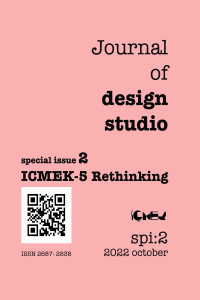Computational approach and morphogenesis
Computational approach and morphogenesis
computational approach, form finding, biology, concept generation, morphogenesis digital tools,
___
- Ahmed, M. M. (2015). Bio-Digital Morphogenesis In Architecture. Alexandria: University of Alexandria.
- Capcarrère M.S., Freitas A.A., Bentley P.J., Johnson C.G., Timmis J. (eds) Advances in Artificial Life. ECAL (2005). Lecture Notes in Computer Science, vol 3630. Springer, Berlin, Heidelberg
- Cheong, H., Hallihan, G., & Shu, L. (2014). Design problem solving with biological analogies: A verbal protocol study. Artificial Intelligence for Engineering Design, Analysis and Manufacturing.
- El-khaldi, M. (2007). Mapping boundries of generative systems for design synthesis. Unpublished Master of Science Thesis . Cambridge, Massachusetts, USA: MIT.
- Granger, R. (2006). Engines of the brain: The computational instruction set of human cognition. Bra in Eng ineer ing Lab orator y.
- İcmeli, B. M. (n.d.). Digital morphogenesis in architectural design . academia.
- Kolarevic, B. (2000). Digital Morphogenesis and Computational Architectures, Constructing the digital space, pp 1-6,
- Kotnik, T., (2010), Digital Architectural Design as Exploration of Computable Functions, International Journal of Architectural Computing, V8, N1, pp. 1-16
- Leach, N., (2009). Digital Morphogenesis . Dessau Institute of Architecture ., Architectural Design, pp 33-37,
- McMillan, L., Wagner, S., Mayfield, M., & Fierro, B. K. (1995, May 15). Dictionary.com. Retrieved May 23, 2018, from http://www.dictionary.com
- Nagel , J. K., & Stone , R. B. (2012). A comutational Approach to biological inspired design . Artifical Intelligence for engineering Design. 26, pp 161176
- Needham, J., (1952) Biochemistry and Morphogenesis, The University Press Österlund, T. (2010). Methods For Morphogenesis And Methods For Ecological In Architecture,. University Of Oulu, Department Of Architecture.
- Oxman, R. (2013). Naturalizing Architecture. Archilab. Roudavski, S. (2009). Toward Morphogenesis in Architecture . International Journal of Architectural Computing, V.7 N.3, pp. 345-374, University of Melbourne.
- Rudge T., Haseloff J., (2005), A Computational Model of Cellular Morphogenesis in Plants. In: (Eds. R. Goebel, J. Siekmann and W.Wahlster). in: Advances in Artificial Life, Lecture Notes in Artificial Intelligence,Vol. 3630, Springer, Heidelberg, 2005, 78- 87.
- Yusuf, H. O. (2012). The Impact Of Digital-Computational Design On The architectural design process . University of Salford.
- Yayın Aralığı: Yılda 2 Sayı
- Başlangıç: 2019
- Yayıncı: Orhan HACIHASANOĞLU
Biophilic Design for Bringing Educational Spaces to Life
Architectural Design Studio Culture
Computational approach and morphogenesis
Contemporary Mosques Conventional and Innovative Approach in Mosque design at Turkey
Obsolete? Relevance of the architect’s role and the changing nature of the architectural profession
Architectural Design Products of Students at Istanbul Fine Arts Academy in 1930's
